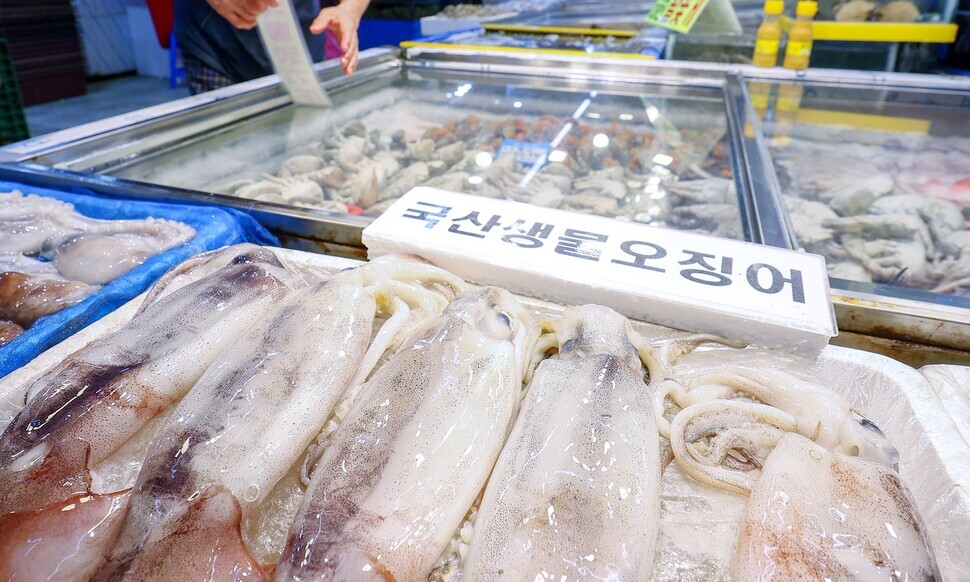hankyoreh
Links to other country sites 다른 나라 사이트 링크
Japan gives reassurances in days after Fukushima dumping, but long-term risks remain unclear

Japan’s Ministry of the Environment announced on Sunday that samples of seawater taken in the vicinity of the Fukushima Daiichi nuclear power plant immediately after the release of the contaminated water began showed the level of the radioisotope tritium to be below the lower limit of detection, at between 7 and 8 becquerels per liter.
However, as the water will continue to be poured into the ocean for at least 30 years, insufficient verification of the long-term risks means that the Japanese government’s initial analysis is not enough to ensure the safety of the discharge itself.
Akihiro Nishimura, the minister of the environment, stated on Sunday that seawater was collected from 11 locations within 40 kilometers of the Fukushima plant on Friday morning, one day after the dumping began, and announced that the analysis of those samples showed there would be “no adverse impact on human health and the environment.”
Earlier on Friday, the ruined nuclear plant’s operator, Tokyo Electric Power Company (TEPCO), announced its own analysis results that the concentration of tritium in seawater collected and analyzed 3 kilometers from the discharge point was below 10 Bq per liter.

The Japan Fisheries Agency announced on Saturday that “one halibut and one bluefin gurnard caught about 5 kilometers away from the nuclear plant were analyzed and found to be below the lower limit of 8 Bq per kilogram,” emphasizing the safety of the contaminated water discharge with additional analysis results.
However, South Korean medical experts have pointed out that the initial analysis based on the information released by the Japanese government does not guarantee safety.
“When a nuclear meltdown occurs, nearly 1,000 types of radioactive substances are produced, but Japan has not disclosed all the radioactive substances detected in the tanks storing the contaminated water at Fukushima,” said Kim Ik-jung, a professor of medicine at Dongguk University who also served as a member of the Nuclear Safety and Security Commission.
“They should disclose all the radioactive substances in the contaminated water tanks to demonstrate its safety, not just disclose the major nuclides that are filtered out by ALPS,” he said, referring to TEPCO’s Advanced Liquid Processing System.
While Japan is sealing the area around the reactors with nets like a caged fish farm to prevent the spread of radioactive materials through the migration of aquatic flora and fauna, those measures “cannot prevent all the microscopic organisms, such as plankton, and other creatures that are moving to other waters due to the disrupted food chain caused by the contamination in the area,” according to Paek Do-myung, a professor emeritus of the Seoul National University Graduate School of Public Health.
“There are different types of radioactive materials that become concentrated in different parts of the food chain, and with the recent warming of sea surface temperatures, the habitats of aquatic organisms are changing, so more discussion is needed to determine the safety of these measures,” he added.
By Shin So-yoon, staff reporter
Please direct questions or comments to [english@hani.co.kr]

Editorial・opinion
![[Editorial] Intensifying US-China rivalry means Seoul must address uncertainty with Beijing sooner than later [Editorial] Intensifying US-China rivalry means Seoul must address uncertainty with Beijing sooner than later](https://flexible.img.hani.co.kr/flexible/normal/500/300/imgdb/original/2024/0517/8117159322045222.jpg) [Editorial] Intensifying US-China rivalry means Seoul must address uncertainty with Beijing sooner than later
[Editorial] Intensifying US-China rivalry means Seoul must address uncertainty with Beijing sooner than later![[Column] When ‘fairness’ means hate and violence [Column] When ‘fairness’ means hate and violence](https://flexible.img.hani.co.kr/flexible/normal/500/300/imgdb/original/2024/0516/7417158465908824.jpg) [Column] When ‘fairness’ means hate and violence
[Column] When ‘fairness’ means hate and violence- [Editorial] Yoon must stop abusing authority to shield himself from investigation
- [Column] US troop withdrawal from Korea could be the Acheson Line all over
- [Column] How to win back readers who’ve turned to YouTube for news
- [Column] Welcome to the president’s pity party
- [Editorial] Korea must respond firmly to Japan’s attempt to usurp Line
- [Editorial] Transfers of prosecutors investigating Korea’s first lady send chilling message
- [Column] Will Seoul’s ties with Moscow really recover on their own?
- [Column] Samsung’s ‘lost decade’ and Lee Jae-yong’s mismatched chopsticks
Most viewed articles
- 1[Editorial] Transfers of prosecutors investigating Korea’s first lady send chilling message
- 2For new generation of Chinese artists, discontent is disobedience
- 3S. Korea “monitoring developments” after report of secret Chinese police station in Seoul
- 4Xi, Putin ‘oppose acts of military intimidation’ against N. Korea by US in joint statement
- 5[Photo] 1,200 prospective teachers call death of teacher “social manslaughter”
- 6[Exclusive] Unearthed memo suggests Gwangju Uprising missing may have been cremated
- 7N. Korean media upgrades epithet for leader’s daughter from “beloved” to “respected”
- 8[Column] Samsung’s ‘lost decade’ and Lee Jae-yong’s mismatched chopsticks
- 9[Editorial] Intensifying US-China rivalry means Seoul must address uncertainty with Beijing sooner t
- 10[Special reportage- part I] Elderly prostitution at Jongmyo Park